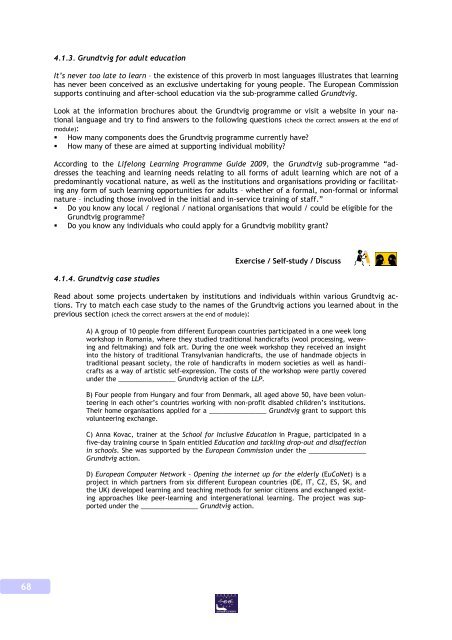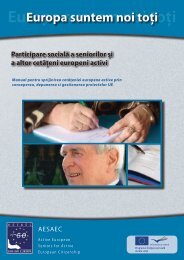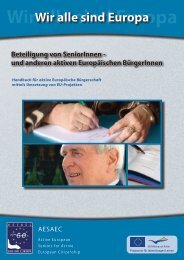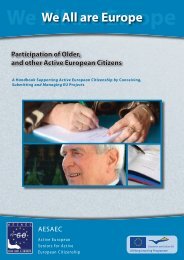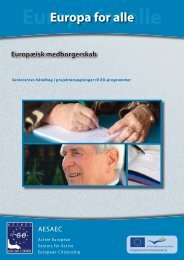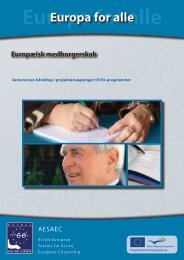We All are Europe - AESAEC
We All are Europe - AESAEC
We All are Europe - AESAEC
Create successful ePaper yourself
Turn your PDF publications into a flip-book with our unique Google optimized e-Paper software.
4.1.3. Grundtvig for adult education<br />
It’s never too late to learn – the existence of this proverb in most languages illustrates that learning<br />
has never been conceived as an exclusive undertaking for young people. The <strong>Europe</strong>an Commission<br />
supports continuing and after-school education via the sub-programme called Grundtvig.<br />
Look at the information brochures about the Grundtvig programme or visit a website in your national<br />
language and try to find answers to the following questions (check the correct answers at the end of<br />
module):<br />
How many components does the Grundtvig programme currently have<br />
How many of these <strong>are</strong> aimed at supporting individual mobility<br />
According to the Lifelong Learning Programme Guide 2009, the Grundtvig sub-programme “addresses<br />
the teaching and learning needs relating to all forms of adult learning which <strong>are</strong> not of a<br />
predominantly vocational nature, as well as the institutions and organisations providing or facilitating<br />
any form of such learning opportunities for adults – whether of a formal, non-formal or informal<br />
nature – including those involved in the initial and in-service training of staff.”<br />
Do you know any local / regional / national organisations that would / could be eligible for the<br />
Grundtvig programme<br />
Do you know any individuals who could apply for a Grundtvig mobility grant<br />
4.1.4. Grundtvig case studies<br />
Exercise / Self-study / Discuss<br />
Read about some projects undertaken by institutions and individuals within various Grundtvig actions.<br />
Try to match each case study to the names of the Grundtvig actions you learned about in the<br />
previous section (check the correct answers at the end of module):<br />
A) A group of 10 people from different <strong>Europe</strong>an countries participated in a one week long<br />
workshop in Romania, where they studied traditional handicrafts (wool processing, weaving<br />
and feltmaking) and folk art. During the one week workshop they received an insight<br />
into the history of traditional Transylvanian handicrafts, the use of handmade objects in<br />
traditional peasant society, the role of handicrafts in modern societies as well as handicrafts<br />
as a way of artistic self-expression. The costs of the workshop were partly covered<br />
under the ________________ Grundtvig action of the LLP.<br />
B) Four people from Hungary and four from Denmark, all aged above 50, have been volunteering<br />
in each other’s countries working with non-profit disabled children’s institutions.<br />
Their home organisations applied for a ________________ Grundtvig grant to support this<br />
volunteering exchange.<br />
C) Anna Kovac, trainer at the School for Inclusive Education in Prague, participated in a<br />
five-day training course in Spain entitled Education and tackling drop-out and disaffection<br />
in schools. She was supported by the <strong>Europe</strong>an Commission under the ________________<br />
Grundtvig action.<br />
D) <strong>Europe</strong>an Computer Network – Opening the internet up for the elderly (EuCoNet) is a<br />
project in which partners from six different <strong>Europe</strong>an countries (DE, IT, CZ, ES, SK, and<br />
the UK) developed learning and teaching methods for senior citizens and exchanged existing<br />
approaches like peer-learning and intergenerational learning. The project was supported<br />
under the ________________ Grundtvig action.<br />
68


